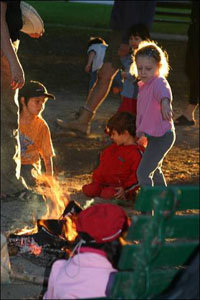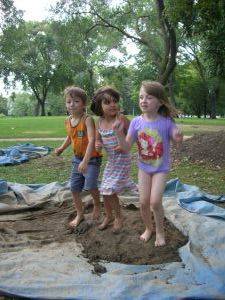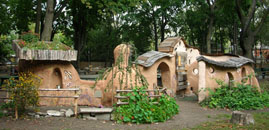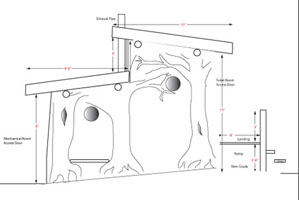Comments?
For the basics, see
- Website & Privacy Policies
- How To Get Involved
- The Role of the Park
Search options:
Department Site Map
Custodians:
Why We Have It
From the Project pages:
posted June 15, 2005
Description of the project

An earthen-walled courtyard, built in the summer of 2005, encloses the space to the northwest of the pool, creating an outdoor gathering place. It is built with a sand-clay-straw mix known as "cob" or "monolithic adobe", which is mixed by foot and applied will enclose the space to the northwest of the pool, creating an outdoor gathering place. It will be built with a sand-clay-straw mix known as “cob” or “monolithic adobe”, which is mixed by foot and applied by hand. It provides a spot for the washing station required by Public Health so that park staff can serve food by the pool in the summer while meeting Public Health requirements. It includes arches, doorways, niches, shelves, benches, a puppet window, sculptures and mosaics, and a green roof. Native plantings are incorporated around and within the courtyard.

Experiential workshops involved the local community in the building of the courtyard, and offered them a chance to learn about natural building techniques. The project offered workshops for classes of local school children, and for the general community. Work bees focusing on specific aspects of construction augmented regular, ongoing workshops. This project aimed to engage all users of the park, especially the parents and children who make the south end of the park their summer home. They are the main users of the structure once it was built, and made sizable contributions to its creation.
posted June 15, 2005
Need for the project
Washing station: Public Health requires a washing station in proximity to the park’s food card that locates itself near the wading pool in the summer, so some sort of shelter or structure is required for this purpose. The food cart earns at about $350 a week – about $3,500 over the summer – which is put straight back into the park (staffi ng, supplies, etc.). Having the washing station will therefore benefit the park continuously.

Gathering place: This heavily used part of the park is lacking a clean, contained area for people to sit and eat their lunch, or for children to engage in activities provided by park staff such as playing dress-up or sitting and reading books. By building a courtyard wall near the pool, we will be defi ning and encompassing the space, and creating a comfortable, attractive location at which to enjoy the park.
Learning opportunities: Other cities in Canada and the US are starting to see the necessity in investigating forms of building and construction that take less of a toll on the environment than currently popular building methods. There is also a need for human-size construction, and most importantly, a craving amongst people to contribute to their own shelter in a more meaningful way than simply paying for it. This project will invite neighbours and friends of the park to become directly involved in the construction, and to learn about natural building techniques.
Recycling: This building method takes materials out of the waste stream and uses them to create structures. For example, clay, and possibly sand, will come from the digging out of basements and foundations; straw is currently a waste product of farming that is often burnt; concrete chunks that will form the foundation will come from ripped-up sidewalks that usually make their way to the landfill.
Community-building: When some neighbours got together over a decade ago and put in some bake ovens in Dufferin Grove Park, it began a tradition of people giving their time and effort to the park, in return for a stronger, more connected community. The courtyard wall project will build on and enhance that tradition.
In addition to creating something beautiful, we will have created another gathering place for neighbours to get to know one another, and for friends to reconnect.
posted June 15, 2005
Who will benefit?

The park:
- Will be able to keep its food cart operations near the pool, along with the attendant revenue.
The park friends and neighbours:
- Will benefit from building the wall physically in terms of health, and community bonding;
- Will continue to enjoy the food cart because the Public
Health requirement for washing facilities will be satisfied;
- Will be able to enjoy the new space and use it freely year round.
Children:
- Will have a clean, safe place to string beads, paint, read and do some of the other activities that the
park staff provide for children;
- Will get to contribute directly to the building.
The city:
- Will be the benefi ciary of a new "facility" at little cost to it;
- Will benefi t from the positive publicity and goodwill that this project generates.
posted April 01, 2007
Quick Cob Figures - Benefits of Cob
Just how much, how many, and what go into (or don't go into) the making of the cob structures?? Here are a few interesting figures to give you an idea of some of the ways cob construction is environmentally and people friendly:

Cob Courtyard Wall
Volunteer Participation
Summer 2005: approx 500 volunteers
Materials diverted from landfill
Clay: 337.5 cubic feet
Concrete: 225 cubic feet
Bio-toilet/Earthen Building (cancelled in 2007)
Volunteer Participation
Summer 2006: approx 200 volunteers  Summer 2007: project on hold
Summer 2007: project on hold
Summer 2008: approx 500 volunteers
Projected total: 700 volunteers
Projected total: 600 volunteers
Materials to be diverted from landfill
Clay: 477 cubic feet
Estimated reduction in conventional toilet uses per season:
Approx 6,900
Estimated water use avoided
(based on 6 litre flush): 41,400 litres
(based on 13 litre flush): 89,700 litres
Average: 65,550 litres
The Phoenix toilet model is rated to take up to 100 uses per day in the summer months. An average season would probably see about 6,900 uses of the facility. Taking this many flushes out of the conventional waste system saves approximately 65,550 litres of potable water from being flushed down the toilet. It also reduces:
|
-Additional water use during the sewage cleansing process; |
-Emissions from creating the energy; |




 Printer friendly version
Printer friendly version